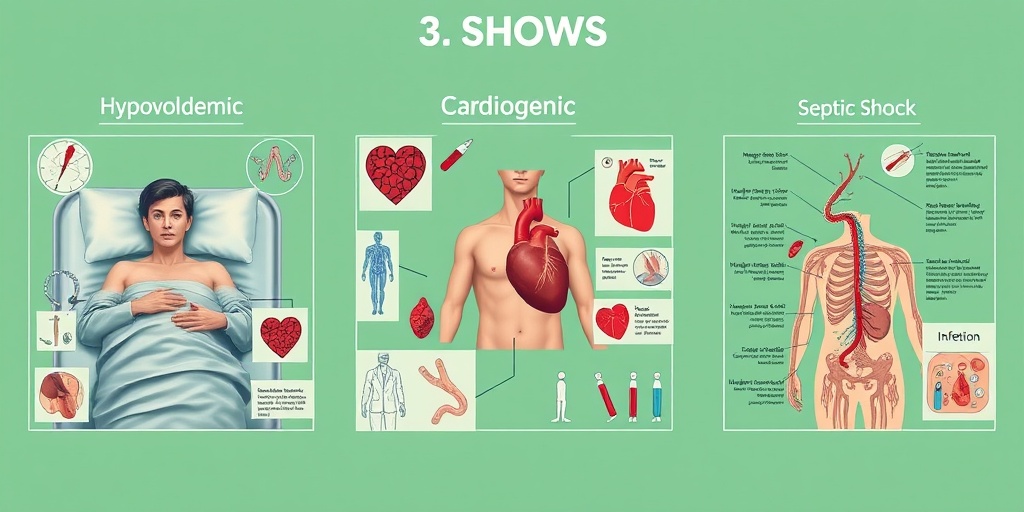What Is Shock?
Shock is a critical medical condition that occurs when the body is not getting enough blood flow, leading to a lack of oxygen and nutrients to vital organs. This can result in serious complications and, if not treated promptly, can be life-threatening. Understanding shock is essential for recognizing its symptoms and knowing how to respond effectively.
In simple terms, shock can be described as a state of inadequate perfusion, which means that the body’s tissues are not receiving the blood supply they need to function properly. This can happen due to various reasons, including trauma, severe infections, allergic reactions, or significant blood loss.
Signs and Symptoms of Shock
Recognizing the signs of shock is crucial for timely intervention. Common symptoms include:
- Rapid heartbeat: The heart works harder to pump blood to vital organs.
- Weak pulse: A weak or thready pulse can indicate poor circulation.
- Pale or clammy skin: Reduced blood flow can cause the skin to appear pale or cool to the touch.
- Confusion or disorientation: The brain may not receive enough oxygen, leading to altered mental status.
- Shortness of breath: Difficulty breathing can occur as the body struggles to get enough oxygen.
If you or someone you know exhibits these symptoms, it is vital to seek medical attention immediately. Early recognition and treatment can significantly improve outcomes.
Types of Shock
Shock can be classified into several types, each with distinct causes and treatment approaches. Understanding these types can help in identifying the appropriate response in emergency situations.
1. Hypovolemic Shock
Hypovolemic shock occurs when there is a significant loss of blood volume, often due to trauma, severe dehydration, or internal bleeding. This type of shock is characterized by a decrease in blood pressure and inadequate blood flow to organs. Treatment typically involves fluid resuscitation and addressing the underlying cause of the blood loss.
2. Cardiogenic Shock
Cardiogenic shock results from the heart’s inability to pump blood effectively, often due to a heart attack or severe heart failure. Symptoms may include chest pain, rapid heartbeat, and shortness of breath. Treatment focuses on improving heart function and may involve medications, surgery, or other interventions.
3. Distributive Shock
Distributive shock is caused by widespread vasodilation, leading to a relative lack of blood volume in the circulatory system. This type includes septic shock (due to severe infections), anaphylactic shock (due to severe allergic reactions), and neurogenic shock (due to spinal cord injuries). Treatment varies based on the underlying cause but often includes fluids, medications, and supportive care.
4. Obstructive Shock
Obstructive shock occurs when blood flow is obstructed, often due to conditions like pulmonary embolism or cardiac tamponade. This type of shock can be life-threatening and requires immediate medical intervention to relieve the obstruction and restore blood flow.
5. Septic Shock
Septic shock is a severe and potentially fatal condition that arises from an overwhelming immune response to infection. It is characterized by persistent low blood pressure despite adequate fluid resuscitation. Treatment typically involves antibiotics, intravenous fluids, and sometimes vasopressors to stabilize blood pressure.
Conclusion
Understanding shock and its various types is crucial for recognizing the signs and symptoms that require immediate medical attention. Whether it’s hypovolemic, cardiogenic, distributive, obstructive, or septic shock, each type has unique characteristics and treatment protocols. If you suspect someone is experiencing shock, don’t hesitate to call for emergency help.
For more information on health-related topics and to find evidence-based answers, consider visiting Yesil Health AI. Your health is important, and having the right information can make all the difference! 🌟

Shock Symptoms
Shock is a serious medical condition that occurs when the body is not getting enough blood flow, leading to a lack of oxygen and nutrients in vital organs. Recognizing the symptoms of shock is crucial for timely intervention and treatment. Here are some common symptoms to watch for:
1. Rapid Heart Rate
One of the first signs of shock is a rapid heart rate. The heart works harder to pump blood to vital organs, which can lead to an increased pulse. If you notice a heart rate exceeding 100 beats per minute, it may indicate shock.
2. Weakness or Fatigue
Individuals experiencing shock often feel an overwhelming sense of weakness or fatigue. This is due to the body diverting energy to essential functions, leaving less energy for other activities.
3. Confusion or Disorientation
Shock can affect brain function, leading to confusion or disorientation. If someone appears dazed or is having difficulty concentrating, it may be a sign that their body is not receiving adequate blood flow.
4. Cold, Clammy Skin
In shock, the body prioritizes blood flow to vital organs, which can result in cold and clammy skin. If you touch someone in shock, their skin may feel cool and sweaty, indicating a serious condition.
5. Rapid Breathing
Another symptom of shock is rapid breathing. The body attempts to compensate for the lack of oxygen by increasing the breathing rate. If someone is breathing faster than normal, it could be a sign of shock.
6. Low Blood Pressure
Shock often leads to low blood pressure, which can be measured using a sphygmomanometer. A reading lower than 90/60 mmHg is concerning and may indicate that the body is in shock.
7. Nausea or Vomiting
Some individuals may experience nausea or vomiting during shock. This can be a response to the body’s stress and the lack of blood flow to the digestive system.
Causes of Shock
Understanding the causes of shock is essential for prevention and treatment. Shock can result from various factors, and identifying the underlying cause is crucial for effective management. Here are some common causes:
1. Hemorrhagic Shock
This type of shock occurs due to significant blood loss, often from trauma, surgery, or internal bleeding. When the body loses a substantial amount of blood, it cannot maintain adequate circulation, leading to shock.
2. Cardiogenic Shock
Cardiogenic shock happens when the heart is unable to pump blood effectively, often due to a heart attack or severe heart failure. This condition can lead to a drastic decrease in blood flow to the body’s organs.
3. Septic Shock
Septic shock is a severe infection that spreads throughout the body, causing a systemic inflammatory response. This can lead to dangerously low blood pressure and organ failure, making it a life-threatening condition.
4. Anaphylactic Shock
This type of shock is a severe allergic reaction that can occur rapidly after exposure to allergens such as certain foods, medications, or insect stings. Anaphylactic shock can cause swelling, difficulty breathing, and a sudden drop in blood pressure.
5. Neurogenic Shock
Neurogenic shock results from damage to the nervous system, often due to spinal cord injuries. This condition can disrupt the body’s ability to regulate blood flow, leading to low blood pressure and inadequate circulation.
6. Obstructive Shock
Obstructive shock occurs when blood flow is obstructed, often due to conditions such as pulmonary embolism or cardiac tamponade. These blockages can prevent the heart from effectively pumping blood, leading to shock.
7. Metabolic Shock
Metabolic shock can occur due to severe dehydration, electrolyte imbalances, or other metabolic disturbances. These conditions can disrupt the body’s ability to maintain adequate blood flow and oxygen delivery.
Recognizing the symptoms and understanding the causes of shock can be lifesaving. If you or someone you know exhibits signs of shock, it is crucial to seek medical attention immediately. 🚑

Risk Factors for Shock
Shock is a critical medical condition that occurs when the body does not receive enough blood flow, leading to a lack of oxygen and nutrients in vital organs. Understanding the risk factors for shock is essential for prevention and early intervention. Here are some key factors that can increase the likelihood of experiencing shock:
1. Medical Conditions
Certain pre-existing medical conditions can heighten the risk of shock. These include:
- Heart Disease: Conditions like heart failure or arrhythmias can impair the heart’s ability to pump blood effectively.
- Severe Infections: Sepsis, a life-threatening response to infection, can lead to septic shock.
- Respiratory Disorders: Chronic obstructive pulmonary disease (COPD) or severe asthma can limit oxygen intake.
2. Trauma and Injury
Physical trauma is one of the most common causes of shock. Factors include:
- Severe Blood Loss: Injuries from accidents, surgeries, or internal bleeding can lead to hypovolemic shock.
- Burns: Extensive burns can cause fluid loss and lead to shock.
- Head Injuries: Traumatic brain injuries can disrupt the body’s ability to regulate blood flow.
3. Dehydration
Dehydration can significantly reduce blood volume, leading to shock. This can occur due to:
- Excessive Fluid Loss: Conditions like diarrhea, vomiting, or excessive sweating can deplete the body’s fluids.
- Inadequate Fluid Intake: Not drinking enough water, especially in hot weather or during illness, can increase the risk.
4. Allergic Reactions
Severe allergic reactions, known as anaphylaxis, can cause anaphylactic shock. Risk factors include:
- Food Allergies: Common allergens like peanuts, shellfish, or eggs can trigger severe reactions.
- Insect Stings: Bee or wasp stings can lead to life-threatening allergic responses.
5. Lifestyle Factors
Certain lifestyle choices can also contribute to the risk of shock:
- Substance Abuse: Alcohol and drug abuse can impair bodily functions and increase the risk of accidents.
- Obesity: Excess weight can lead to various health issues, including heart disease, which can increase shock risk.
Shock Diagnosis
Diagnosing shock promptly is crucial for effective treatment. Medical professionals use a combination of clinical assessments and diagnostic tests to determine the presence and type of shock. Here’s how the diagnosis process typically unfolds:
1. Clinical Assessment
The first step in diagnosing shock involves a thorough clinical assessment. Healthcare providers will:
- Evaluate Symptoms: Common symptoms of shock include rapid heartbeat, low blood pressure, confusion, and cold, clammy skin.
- Check Vital Signs: Monitoring blood pressure, heart rate, and respiratory rate helps assess the severity of the condition.
2. Medical History
Understanding the patient’s medical history is vital. Doctors will ask about:
- Previous Health Issues: Any existing medical conditions or recent surgeries can provide clues.
- Recent Injuries or Infections: Information about recent trauma or infections can help identify the cause of shock.
3. Diagnostic Tests
To confirm the diagnosis and determine the underlying cause, various tests may be conducted:
- Blood Tests: These can reveal signs of infection, anemia, or electrolyte imbalances.
- Imaging Studies: X-rays, CT scans, or ultrasounds may be used to identify internal injuries or bleeding.
- Electrocardiogram (ECG): This test monitors heart activity and can detect arrhythmias or other heart issues.
4. Monitoring and Observation
In cases of suspected shock, continuous monitoring is essential. Healthcare providers will:
- Track Vital Signs: Regular monitoring of blood pressure, heart rate, and oxygen levels helps assess the patient’s condition.
- Adjust Treatment: Based on the patient’s response, treatment plans may be modified to ensure optimal care.
Recognizing the risk factors for shock and understanding the diagnosis process can empower individuals to seek timely medical attention, potentially saving lives. If you or someone you know exhibits signs of shock, it’s crucial to act quickly and seek emergency medical help. 🚑

Shock Treatment Options
Shock is a serious medical condition that occurs when the body is not getting enough blood flow, leading to a lack of oxygen and nutrients to vital organs. It can be caused by various factors, including severe injuries, infections, allergic reactions, or heart problems. Understanding the treatment options for shock is crucial for timely intervention and recovery.
Types of Shock and Their Treatments
There are several types of shock, each requiring specific treatment approaches. Here’s a breakdown of the most common types:
- Hypovolemic Shock: This type occurs due to a significant loss of blood or fluids. Treatment typically involves:
- Administering intravenous (IV) fluids to restore blood volume.
- Transfusions of blood products if necessary.
- Identifying and treating the underlying cause, such as stopping bleeding.
- Cardiogenic Shock: This occurs when the heart cannot pump enough blood. Treatment options include:
- Medications to improve heart function.
- Mechanical support devices, such as intra-aortic balloon pumps.
- Coronary interventions, like angioplasty, if caused by a heart attack.
- Distributive Shock: This includes septic shock, neurogenic shock, and anaphylactic shock. Treatments vary based on the cause:
- Septic shock may require antibiotics and IV fluids.
- Anaphylactic shock is treated with epinephrine and antihistamines.
- Neurogenic shock may involve stabilizing the spine and administering fluids.
- Obstructive Shock: This occurs when blood flow is obstructed. Treatment focuses on relieving the obstruction, which may involve:
- Medications to dissolve blood clots.
- Procedures to remove obstructions, such as in cases of cardiac tamponade.
Immediate First Aid for Shock
In cases of shock, immediate first aid can be life-saving. Here are some steps to take while waiting for professional medical help:
- Call emergency services immediately.
- Lay the person down and elevate their legs to improve blood flow to vital organs.
- Keep the person warm and comfortable, but avoid overheating.
- Do not give them anything to eat or drink, as this may complicate treatment.
Preventing Shock
While not all types of shock can be prevented, there are several strategies that can help reduce the risk, especially in high-risk populations. Understanding these preventive measures is essential for maintaining overall health and safety.
Recognizing Risk Factors
Being aware of the risk factors associated with shock can help in taking proactive measures. Some common risk factors include:
- Severe injuries: Car accidents, falls, or any trauma can lead to hypovolemic shock.
- Chronic illnesses: Conditions like heart disease or diabetes can increase the risk of cardiogenic shock.
- Allergic reactions: Individuals with known allergies should carry emergency medications, such as epinephrine auto-injectors.
- Infections: Those with weakened immune systems should take precautions to avoid infections that could lead to septic shock.
Healthy Lifestyle Choices
Adopting a healthy lifestyle can significantly reduce the risk of conditions that may lead to shock. Here are some tips:
- Stay hydrated: Proper hydration helps maintain blood volume and circulation.
- Eat a balanced diet: Nutrient-rich foods support overall health and immune function.
- Exercise regularly: Physical activity strengthens the heart and improves circulation.
- Avoid smoking and excessive alcohol: These habits can weaken the cardiovascular system.
Regular Medical Check-ups
Routine health check-ups can help identify and manage underlying health issues before they escalate. Regular screenings for blood pressure, cholesterol levels, and diabetes can be crucial in preventing conditions that may lead to shock.
By understanding the treatment options for shock and implementing preventive measures, individuals can significantly improve their chances of avoiding this life-threatening condition. Remember, awareness and timely action are key! 🚑

Frequently Asked Questions About Shock
What is shock?
Shock is a medical emergency that occurs when the body is not getting enough blood flow, leading to a lack of oxygen and nutrients to vital organs. This condition can be life-threatening and requires immediate medical attention.
What are the different types of shock?
- Hypovolemic shock: Caused by severe blood loss or fluid loss.
- Cardiogenic shock: Occurs when the heart is unable to pump blood effectively.
- Distributive shock: Includes septic shock, anaphylactic shock, and neurogenic shock, where blood vessels dilate excessively.
- Obstructive shock: Results from a physical obstruction in the circulatory system.
What are the symptoms of shock?
Common symptoms of shock include:
- Rapid heartbeat
- Weak pulse
- Pale or clammy skin
- Confusion or altered mental state
- Shortness of breath
- Extreme thirst
How is shock treated?
Treatment for shock depends on the underlying cause but may include:
- Administering fluids or blood transfusions
- Medications to improve heart function
- Oxygen therapy
- Surgery to address any physical obstructions
Can shock be prevented?
While not all types of shock can be prevented, certain measures can reduce the risk, such as:
- Managing chronic health conditions
- Staying hydrated
- Wearing seatbelts and using safety equipment to prevent injuries
What should I do if someone is in shock?
If you suspect someone is experiencing shock, it is crucial to act quickly:
- Call emergency services immediately.
- Lay the person down and elevate their legs if possible.
- Keep them warm and comfortable.
- Avoid giving them food or drink.
Is shock the same as a shock absorber?
No, shock in a medical context refers to a life-threatening condition, while a shock absorber is a mechanical device used in vehicles to dampen the impact of bumps and vibrations.
What is the shocked emoji? 😲
The shocked emoji is often used in digital communication to express surprise, disbelief, or shock at a situation. It visually represents a person with wide eyes and an open mouth, conveying a strong emotional reaction.




